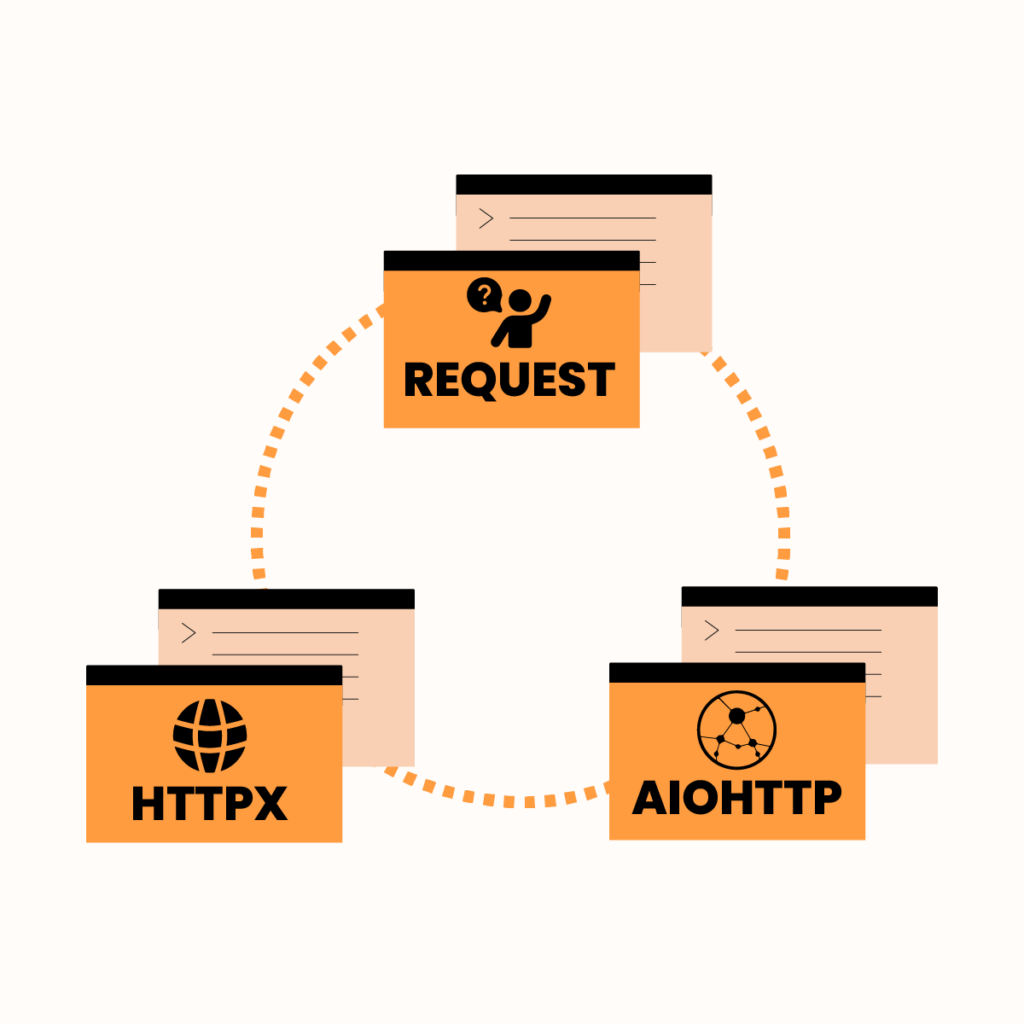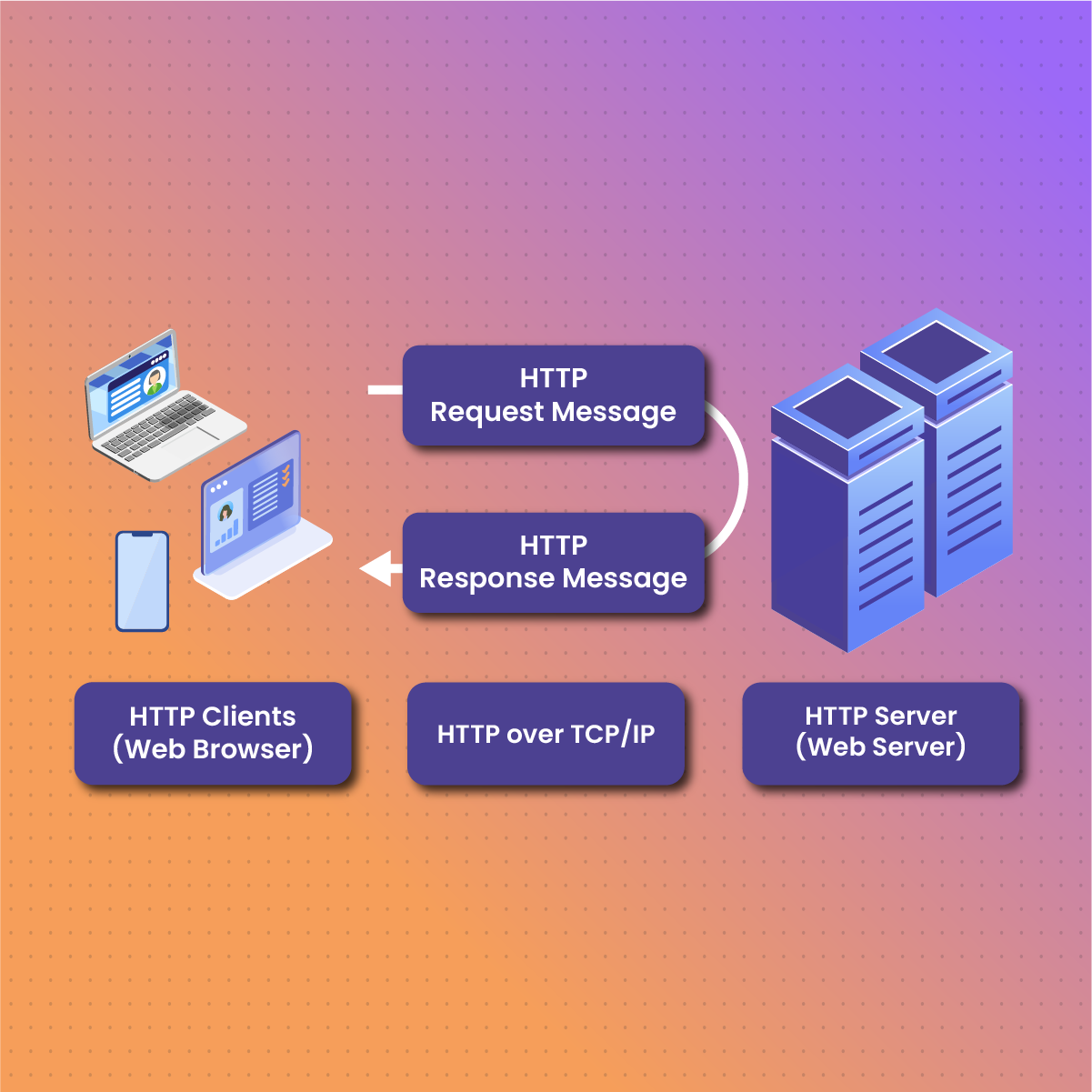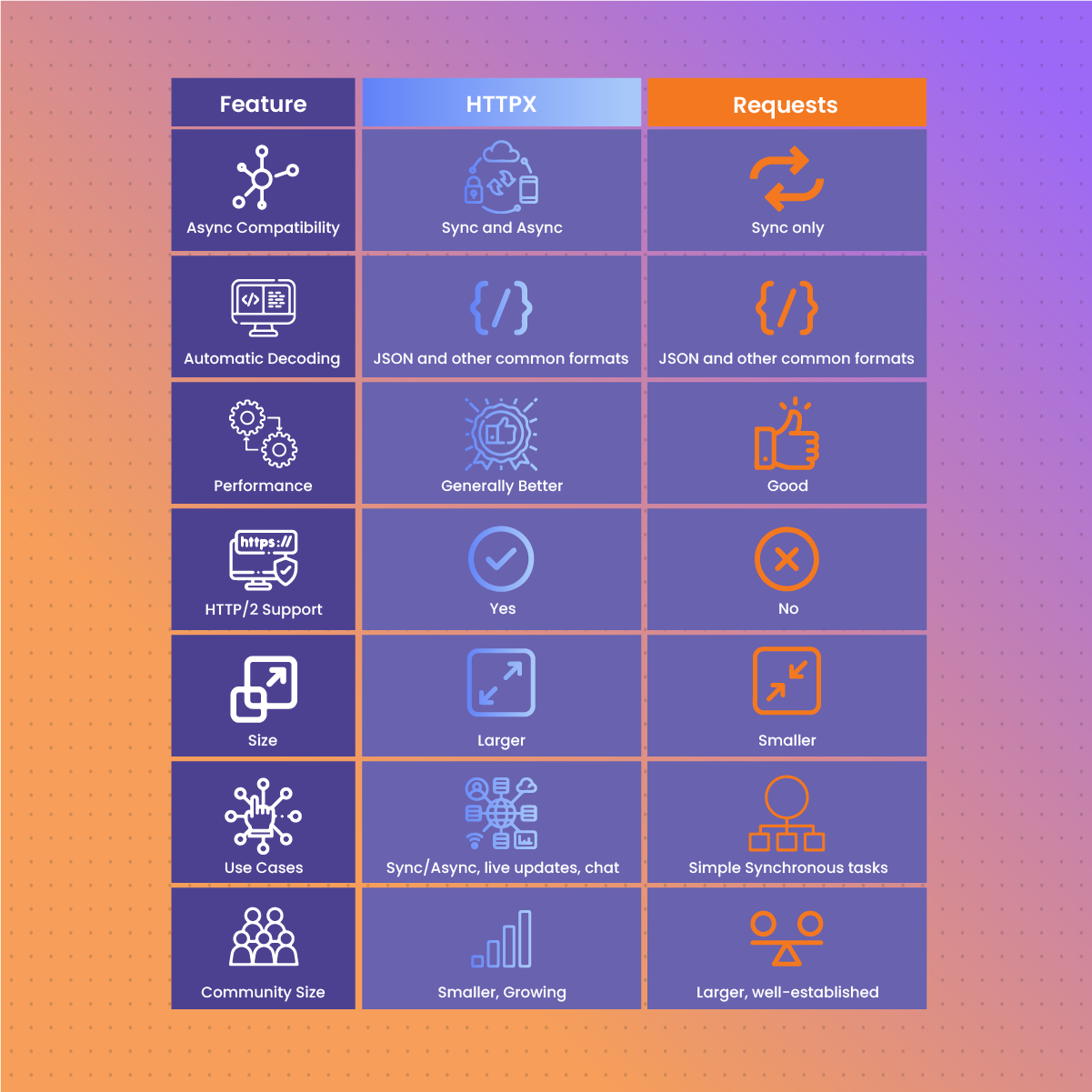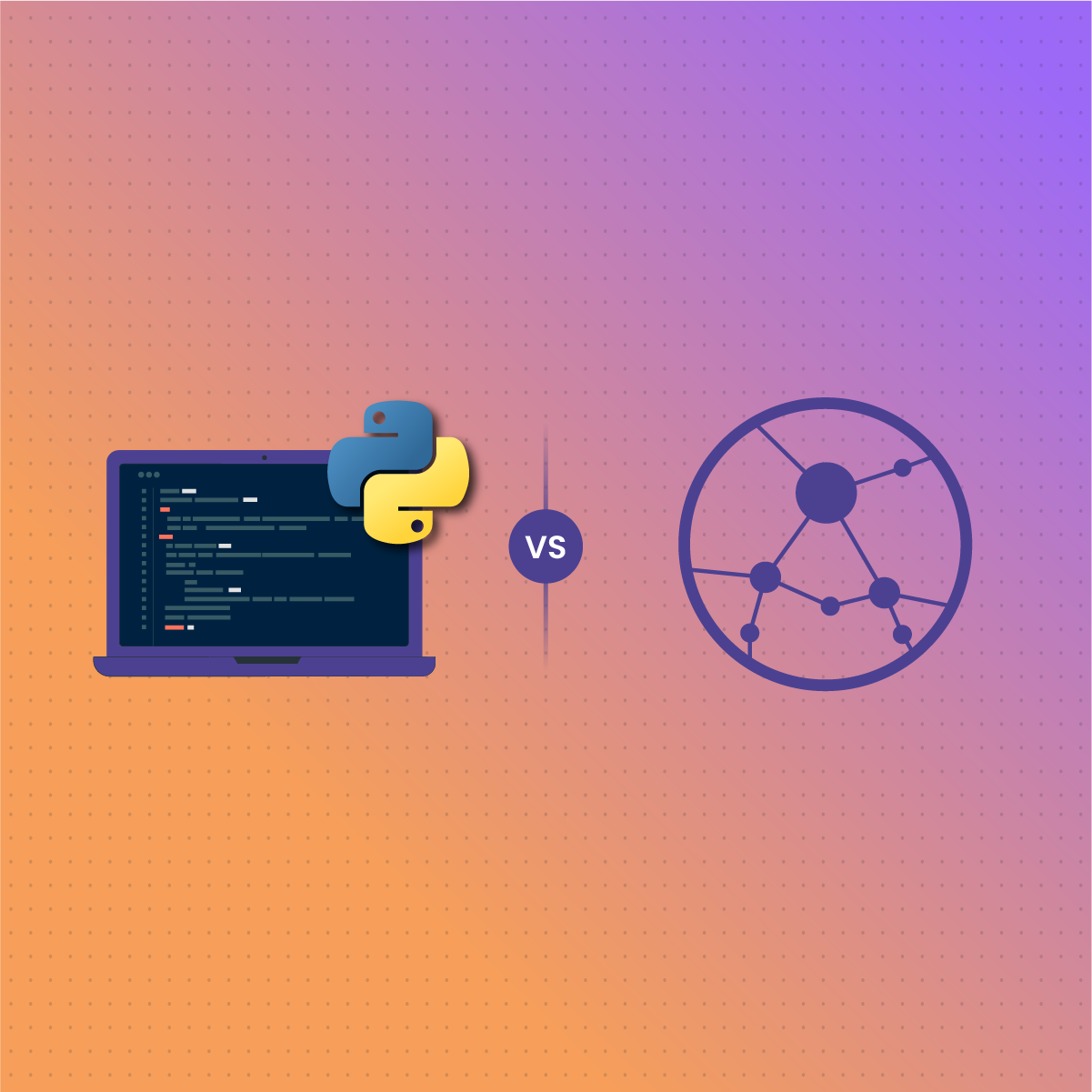Introduction
Hypertext Transfer Protocol (HTTP) is a client-server protocol that serves as the basis of all web data exchanges. However, there are various tools for making HTTP requests such as HTTPX vs. Requests vs. AIOHTTP. These Python clients are used to simplify HTTP requests, so it is crucial to understand their use cases, capabilities, and features. Subsequently, understanding the differences between HTTPX vs. Requests vs. AIOHTTP plays a significant role in how you use HTTP requests.
Let us dive in!
Introduction to HTTP
HTTP allows communication between clients and servers. Browsers rely on HTTP request to retrieve information required to load the website. This protocol stands out for its flexibility, which allows you to modify it to fetch multiple forms of content such as HTTP documents, images, and videos.
Although browsers are mainly used to send HTTP requests, any agent such as proxies can send them. In recent years, many web scrapers are heavily reliant on proxies for effective web data extraction. Bear in mind that various entities are working together for adequate handling of requests and responses.
Here are the components of HTTP request:
HTTP version type
One of the components of an HTTP request is the version type. Although HTTP has various versions, the commonly used one is HTTP/1.0. However, it supports HTTP/ 2.0, which is a newer version, which has more functionality.
URL
The URL is a shortened version of Uniform Resource Locator and it acts as a unique identifier for searching for resources on the web. Subsequently, the URL has several parts that tell the web browser how and where to fetch a resource.
HTTP method
A crucial component of HTTP requests is the method. It indicates the action that the HTTP request expects from the server. Common HTTP methods are POST and GET. Subsequently, the HTTP GET function is to request data from a specific resource. Here are some things you need to know about the GET requests:
- It can be bookmarked and cached
- GET requests have length restrictions
- Can only be used to request data and not modify it
- Not suitable for sensitive data as the components are transmitted as plain text
- It remains in the browser
On the other hand, the POST requests send data to create or update a resource. Some of its features include:
- POST requests are never cached
- It does not remain in the browser history
- No restrictions on data length
- Can’t be bookmarked
HTTP request headers
The request headers are a component of every HTTP request and response. They convey crucial data, such as the data being requested and the browser version.
HTTP request body (optional)
The HTTP request body is an optional form of data. It usually includes the body of information submitted to the target website.
HTTP response
The HTTP response is what the client receives from the client. In addition, the type of data requested determines the response retrieved. It usually contains:
- HTTP status code
- HTTP response header
- HTTP response body (optional)
Using HTTPX vs. Requests vs. AIOHTTP
Installation
Before you use any of these Python libraries, you need to install them via your terminal.
python -m pip install requests httpx aiohttp asyncio
HTTPX vs. Requests vs. AIOHTTP: Sending a GET request
Let us consider some differences between the libraries in terms of codes. The code below shows how to use the Request library GET function:
import requests
response = requests.get(“https://example.com”)
print(response.text)
Here is the GET function for HTTPX library:
import httpx
response = httpx.get(“https://example.com”)
print(response.text)
Another method is to create an httpx client object and use its get method, as shown below:
client = httpx.Client()
response = httpx.get(“https://example.com”)
HTTPX vs. Requests: Sending a POST request
This is the code for using the Request library:
response = requests.post(“https://www.example.com”, data= {“name”: “May”, “age”: 25})
However, the code looks like this if you are using HTTPX:
client = httpx.Client()
response = client.post(“https://www.example.com”, data={“name”: “May”, “age”: 25})
HTTPX vs Requests: async function
HTTPX and Requests use is very similar to that for synchronous programs. However, only HTTPX allows you to write asynchronous codes, as shown below:
import httpx
import asyncio
async def main():
async with httpx.AsyncClient() as client:
response = await client.get(“https://example.com”)
print(response.text)
asyncio.run(main())
HTTPX supports automatic decoding of JSON and other common formats. Subsequently, this saves time and effort when working with structured data.
import httpx
response = httpx.get(“https://www.example.com/get”)
data = response.json()
print(data[“headers”][“User-Agent”])
For the Request Library syntax:
import requests
response = requests.get(“https://www.example.com/get”)
data = response.json()
print(data[“headers”][“User-Agent”])
Introduction: HTTPX vs Requests vs AIOHTTP
Requests library
Requests is a Python library that makes it easy to send HTTP requests and process responses. Subsequently, this library makes it easier to add data like headers to an HTTP request.
In addition, it retrieves responses in various formats like text, JSON, or binary. The Request library is widely used because of its simplicity, versatility, and comprehensive documentation. It also supports the use of residential proxies for effective web scraping.
Here are some features of the Requests library:
- Requests library decompresses HTTP responses before sending them to the client.
- In addition, it verifies the security of SSL/TLS provided by servers.
- It decodes responses with Unicode character encoding
- Requests support basic authentication methods, including username and password. Subsequently, it allows for the use of premium proxies to bypass geographic restrictions.
- This library allows programs to establish a specific waiting period before raising an exception indicating a connection error.
HTTPX library
HTTPX is a Python client library that offers more flexibility and functionality than the Request library. This library stands out because it supports asynchronous and synchronous HTTP requests. In addition, HTTPX allows users to run multiple queries through the retryablehttp library, which is designed to be faster, more reliable and with increased threads. Apart from finding the HTTP server, HTTPX includes various other features like:
- Retrieving domains from content security privacy
- HTTPX offers automatic decompression
- It allows you to make reports directly to WSGI and ASGI applications.
- This library supports the old and updated versions of HTTP
- It is designed to be a fast and reliable option with async and synchronous supports.
- It has a strict timeout
What is AIOHTTP?
Also known as Asynchronous Input Output HTTP, AIOHTTP is an asynchronous HTTP client library that supports HTTP/1.1 and HTTP/2 protocols. In addition, it supports concurrency, which means that multiple connections can run simultaneously without interfering with each other. This is an important feature, especially if you need the HTTP client library for web scraping.
Concurrency is crucial in modern applications because it allows you to handle more requests without handling a large amount of resources. In addition, you can use this library to build asynchronous programs that can interact with different APIs. Other features of AIOHTTP include:
- It offers session management
- Provides support for managing multiple consent types
- Supports connection pooling
- Seamless integration into other casino-based libraries
- You can use this library to make asynchronous POST requests.
- It allows you to send and receive data without using low-level transports, callbacks, or protocols
Comparison Between HTTPX and the Request Library
Requests is one of the most popular and widely used Python libraries for sending HTTP requests. It has a simple API, which makes it an ideal choice for many developers. On the other hand, HTTPX is a more recent and feature-dense HTTP client for Python. Here are some differences between HTTPX and Requests Libraries:
Async compatibility
The primary difference between HTTPX and Requests is the async compatibility. HTTPX has both sync and async compatibility, meaning you can use it in both synchronous and asynchronous programs. On the other hand, you can only use the Request library in synchronous programs.
Automatic decoding
Regarding HTTPX vs. Requests libraries, they both include automatic decoding of JSON and other common formats. Subsequently, this feature allows developers to save time and effort when working with responses that contain structured data.
Performance
In most cases, the HTTPX library performs better than the Request library.
HTTP/ 2 support
Another feature that sets the HTTPX library apart from the Requests library is support for HTTP/2- the latest HTTP protocol version. However, the Requests library does not have this feature.
Size
For applications where size is a concern, it is great to understand that the HTTPX library is larger than Request.
Use Cases
The application between HTTPX vs. Requests are very different. Requests library is better suited for simple synchronous projects including basic data retrieval and submission. However, HTTPX supports asynchronous programing which makes it perfect for live data updates and chat platforms.
Community size
Although HTTPX is gaining an increasing population, it is still not as popular as Requests. Subsequently, Requests has a larger community, which makes it easier to find resources that can optimize your activities.
AIOHTTP vs Requests
AIOHTTP and Requests are also popular HTTP libraries for Python projects. Both libraries support cookies, redirects, custom headers, and custom headers. In addition, they are smaller than HTTPX. Here are some differences between them:
Ease of use
Although Python is a simple language with a simple syntax, the ease of use differs between Requests vs. AIOHTTP. Subsequently, the Request library is easier to use, while the AIOHTTP may present a challenge for those new to asynchronous programming.
Contrasting programming paradigms
One of the main differences between Requests vs. AIOHTTP is their programming paradigms. The Requests library supports synchronous programming, while AIOHTTP supports asynchronous programming.
Use cases
Another difference between Requests vs. AIOHTTP is their applications. Since Requests deals with synchronous HTTP requests, it is used for projects that do not require real-time interactions and high concurrency. On the other hand, AIOHTTP is used for applications that demand concurrency and high level responsiveness.
Automatic JSON decoding
Another significant difference between Requests vs. AIOHTTP is that the former has automatic JSON decoding while AIOHTTP does not.
HTTPX vs AIOHTTP
One of the significant differences between HTTPX and AIOHTTP is the functionalities of their libraries. HTTPX is a full-featured HTTP client that can be used for a wide range of applications. On the other hand, AIOHTTP focuses on providing a simple and effective API for making asynchronous HTTP requests.
In addition, the HTTPX library supports both asynchronous and synchronous programming. Meanwhile, AIOHTTP only supports async programs. Regardless, AIOHTTP stands out because it does not only send HTTP requests but can be used to create HTTP servers.
Subsequently, if you are working on only async projects and you need a library that optimizes async programs, then AIOHTTP may be the ideal choice for you. However, if you need a library that can cater to various projects, HTTPX may be the better alternative.
Furthermore, HTTPX and AIOHTTP are both flexible and powerful HTTP clients for Python. They have numerous features ideal for distinct types of projects. Let us go over the core differences:
- HTTPX supports both async and sync projects, while AIOHTTP is the async-focused library.
- While HTTPX is compatible with HTTP/2- the latest version of the HTTP protocol, AIOHTTP does not.
- In terms of performance, AIOHTTP takes the lead as it has better performance, especially when handling large volumes of data. Although HTTPX performs well, its efficiency declines with an increase in workload.
Conclusion
This article has systematically examined the difference between HTTPX vs. Requests vs. AIOHTTP. The choice of an HTTP client library significantly relies on your specific need as they have unique strengths and limitations.
Subsequently, HTTPX may be an excellent solution when you need a simple and easy-to-use library that supports async programs. Similarly, AIOHTTP is an ideal solution for real-time applications like live data updates due to the async support. Meanwhile, Request is a simple library best suited for synchronous projects like data retrieval, prototyping, etc.
Furthermore, if you need a more efficient alternative for web scraping, NetNut Scraper API delivers real-time data from the web at a fast speed at the most competitive price. Contact NetNut support if you have any questions regarding solutions for effective web scraping proxies.
Frequently Asked Questions
HTTPX vs. Requests vs. AIOHTTP: Which is best for web scraping?
Although Python has several libraries for web scraping, HTTPX, requests, and AIOHTTP are the most common options. Requests is the oldest library and has many resources. However, it does not support asyncio or HTTP2.
AIOHTTP supports asyncio so it can be used to make asynchronous request. Subsequently, its features optimizes the speed of the web scraper. On the other hand, HTTPX is a newer library for HTTP clients in Python. In addition, it offers crucial HTTP2 support and it supports the asyncio function. Subsequently, these features make it an ideal library for web scraping.
What is the best choice for using AIOHTTP?
This Python framework is suitable for the following situations:
- A high volume of HTTP traffic, which is effective in handling many concurrent requests without IP blocks.
- It provides two-way, real-time communication between the server and an application. AIOHTTP supports WebSocket, which makes it an ideal choice for chat applications and live data updates.
- AIOHTTP is highly scalable since it is built for performance. Subsequently, it can handle many connections at the same time
What are the key features of HTTPX?
- HTTPX uses asynchronous connections, so it focuses on high speed and performance. Therefore, it becomes a great option for handling high HTTP traffic.
- It supports large data transfers, which allows you to process and handle a large amount of data effectively.
- It provides detailed request control so you can customize request parameters like headers, delays, and authentication methods.
- HTTPX allows you to access data in various formats, such as iterating over lines or reading the entire response as a text.
- It automatically handles compressed responses related to data handling. In addition, you can manage retries by configuring it to retry for failed applications.
- HTTPX supports the asyncio library, which is necessary to enable asynchronous programming for efficient concurrent requests.









